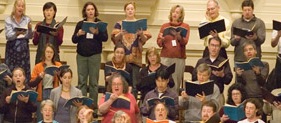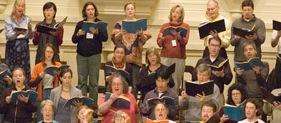I must have been caught in some sort of Bach nexus to review three concerts of the composer's choral works over the past three weeks. Saturday's performance of Bach's B-minor Mass by the San Francisco Bach Choir at the Calvary Presbyterian church gave me a unique opportunity to observe the effect of artistic leadership and performing environment on a period instrument band with the same concertmistress, a majority of the same instrumentalists, and even common soloists. Unfortunatley, Saturday's performance suffered from the uninspired leadership of the choir's Artistic Director Corey Jamason.

I avoid critiquing volunteer and amateur ensembles because, as an outsider, I am not in a position to determine standards and levels of achievement with groups that, by nature, fall short of professional expectations. I was in a unique position Saturday, as I had stepped in as the Bach Choir's assistant conductor for several months in 2006 to help prepare the B-minor Mass, as the previous music director suffered from deteriorating health. Saturday's performance was below the choir's potential.
I had the impression that Jamason, music director since 2007, instead of identifying vocal problems and offering suggestions of how to sing better, simply told the choristers to sing less — especially during exposed and tricky passages. The result was an unfocused and a far less robust sound than I knew was capable with this group. Even basic choral problems, such as avoiding an American lilt in words like terra, went unadressed.
Jamason's conducting seemed unsure, with most movements starting in one tempo and settling into another, and flapping his arms in unclear scowls of frustration. Part of this may be an understandable lack of rehearsal time with the expensive orchestra, but that is exactly what a conductor is supposed to do: compensate for the lack of time by giving assured, encouraging, and inviting gestures. A messy tenor entrance opening the "pleni sunt coeli" was due to Jamason's lack of clarity and not any fault of the choir members. Jamason, a talented keyboardist, seemed to battle over tempo with concertmistress Elizabeth Blumenstock in the famously difficult violin solo in the "Laudamus te" movement, frustrating even her usually superb playing. The string playing in general was muted and restrained, yet this is music that thrives on crisp delineation of the intricate musical lines. Veteran oboist Marc Schachman simply ignored Jamason's upbeat to the "Qui sedes" movement and took a tempo that worked; the result was the best instrumental playing of the evening.

Tenor Brian Thorsett, with his typically refined tone, and flutist Louise Carlake deftly handled the Benedictus. The aria "Quonium to solus sanctus" with its famously difficult horn solo was simply a mess. Bass Paul Murray made it through it. Soprano Jennifer Paulino sang with assured clarity, and Danielle Reutter-Harrah performed a very lovely Agnus Dei.
With such a wealth of resources as his disposal, it was a shame Jamason failed to harness them to give a compelling interpretation of the work. Alexandra Amati-Camperi's lucid program notes would have been one starting point. Bay Area audiences had the option of attending Soli Deo Gloria's performance of the work in Palo Alto the same evening; in addition, the San Francisco Symphony gave five performances in March, the American Bach Soloists is performing the work in July, and the Pacific Collegium has programmed it for September. With such oversaturation, I wanted to find aspects of Jamason's interpretation and Saturday's performance that would speak to those outside of the Bach Choir's local constituency. I found none.

